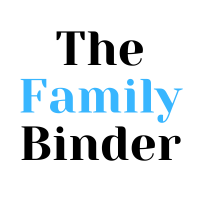Imagine walking into your space where everything feels calm, productive, and under control. No clutter greets you, just a sense of effortless order from the moment you arrive.
This guide is your roadmap to organize home environments with strategies tailored for 2025. You’ll discover expert tips, the latest trends, and actionable methods that empower you to create a stress-free living space.
We’ll explore current organization ideas, room-by-room solutions, smart decluttering techniques, tech integrations, and essential maintenance habits. Everything you need to organize home life efficiently is right here.
Ready to transform your space? Dive in and unlock a serene, functional home using practical steps that truly work.
The 2025 Home Organization Mindset: Trends & Principles
Imagine starting each day in a space that feels refreshing, intentional, and ready for anything. To organize home efficiently in 2025, it’s essential to understand the mindsets and trends shaping how we live and tidy up. Let’s explore what’s new, what works, and why these principles can completely transform your space.
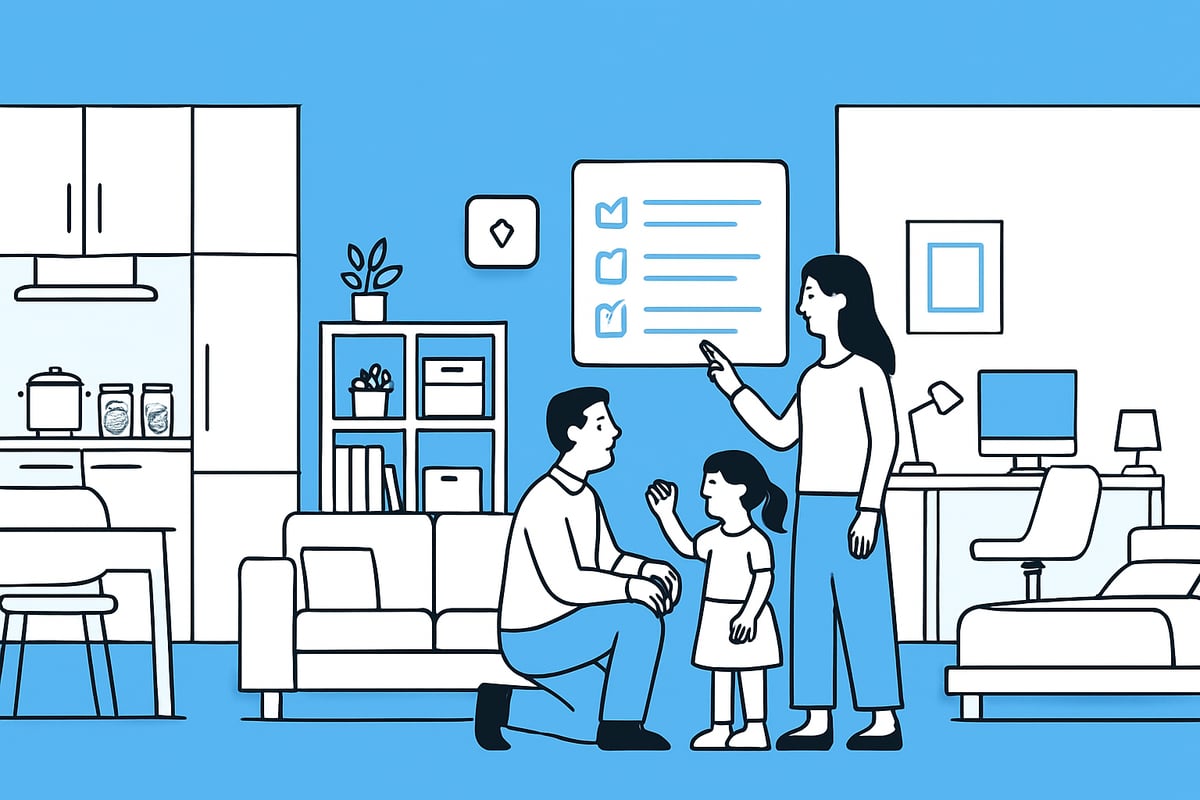
Embracing Minimalism and Sustainability
Minimalism is at the heart of how people organize home spaces this year. By focusing on what truly adds value, you can create rooms that are both beautiful and functional. Families are swapping out mismatched containers for glass jars and choosing uniform dishware, making storage easier and more eco-friendly.
Sustainability matters more than ever. Households are reducing single-use plastics and seeking products that last. For example, switching to reusable storage options not only cuts clutter but also supports a greener planet. According to Home Organization Trends for 2025, eco-friendly materials and multifunctional pieces are leading the way in modern home organization.
Smart Home Integration for Organization
In 2025, technology is a game-changer when you organize home routines. Over 60% of households now use at least one smart device to stay on top of daily tasks. Smart labels and inventory tracking apps make it simple to know what you have and what you need.
Voice assistants are the new personal organizers, helping you remember to reorder supplies or check off chores. Imagine a smart fridge that tracks your pantry inventory and suggests shopping lists. These tools let you maintain order with less effort, making organization feel almost automatic.
The Power of Routine and Maintenance
Consistency is the secret ingredient when you organize home spaces for the long haul. Quick daily resets—like a five-minute tidy or a weekly declutter—keep chaos from creeping in. Start with just one room, and you’ll notice a domino effect across your whole house.
Experts call this the 3 Rs: Reduce clutter, be Resourceful with what you have, and stay Resilient when things go off track. Simple routines, like sorting mail every morning or resetting the living room each night, build habits that last.
Personalization and Flexibility
No two families organize home exactly the same way. The best systems adapt to your lifestyle, not the other way around. Multi-functional furniture and modular shelving allow you to tweak your setup as your needs change.
For example, a modular bookshelf can grow with your kids or shift from toy storage to a home office hub. Flexible solutions ensure every family member feels comfortable and invested in maintaining order.
The Psychological Benefits of an Organized Home
When you organize home thoughtfully, the benefits go far beyond a tidy space. Studies show that organized environments reduce stress and boost productivity. A calm, clutter-free home invites relaxation and supports mental well-being.
You’ll notice better focus, improved sleep, and a more welcoming atmosphere for everyone. The effort you put into organization pays off in happiness and peace of mind, making every day a little bit brighter.
Step 1: Assess & Prioritize Your Spaces
Before you dive into new baskets or fancy shelves, it’s crucial to look at your home with fresh eyes. Assessing and prioritizing is the foundation that will help you organize home in a way that truly fits your lifestyle. Let’s break down this essential first step into manageable, actionable pieces.
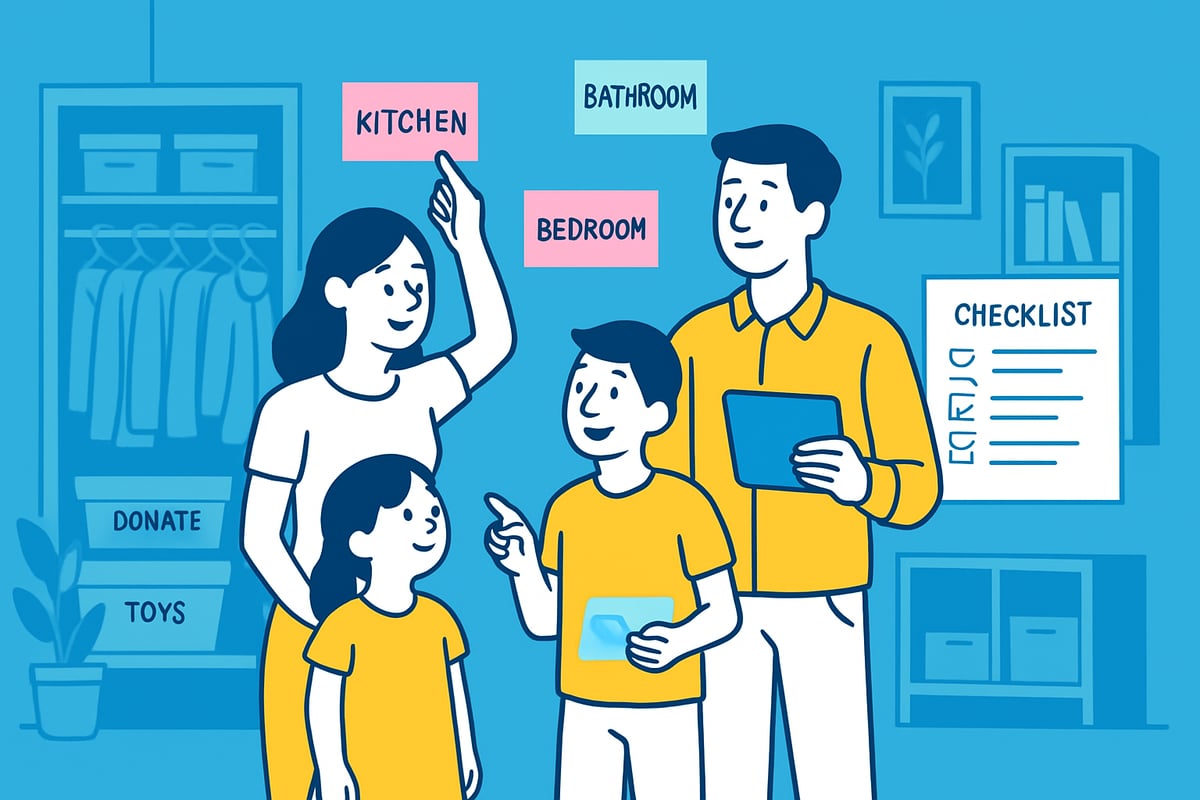
Identifying High-Impact Areas
Start by pinpointing which spaces generate the most daily stress. Kitchens often act as the “command center,” while entryways and closets quickly become clutter magnets. Use a home audit checklist to walk room by room and note where clutter piles up or routines break down.
Common hotspots include:
- Entryways with shoes and bags everywhere
- Kitchens with overflowing counters
- Closets jammed with rarely worn clothes
For more actionable steps on how to organize home by focusing on these high-impact areas, check out these room-by-room organizing strategies.
Setting Clear Goals and Expectations
Decide what “organized” means for your household. Maybe you want to find every item in under a minute, or perhaps you’re aiming for a calm, visually tidy space. Involve everyone who lives with you to set realistic expectations and shared goals.
Prioritize rooms by how often they’re used and how much they impact your daily routine. Agree on what success looks like, so you can organize home in a way that everyone supports and understands.
Inventory and Declutter: The Foundation
Take inventory of everything in each space. Open every drawer, shelf, and bin. Sort items into four categories: keep, donate, recycle, and toss. Did you know the average American discards 81 pounds of clothing per year? Clearing out mismatched containers and unused gadgets is a great way to start.
Once you finish inventory, you’ll have a clear picture of what you own and what truly deserves a place as you organize home.
Overcoming Emotional Barriers
Letting go of items can be tough, especially things with sentimental value. Try focusing on what you want to keep, not just what to discard. Use the “one-in, one-out” rule: for every new item that enters, another must leave.
If you’re stuck, ask yourself:
- Does this item serve a purpose right now?
- Does it bring joy or add stress?
- Would I buy it again if I saw it today?
These questions can help you organize home with less emotional resistance.
Tools for Assessment
Leverage tools to make the process smoother. Printable checklists and digital audit apps keep you on track. Color-coded sticky notes are perfect for sorting decisions as you go. Consider taking before-and-after photos with your smartphone to visibly track progress.
Organize home assessment becomes easier when you can literally see your achievements and adjust your plan as needed.
Step 2: Room-by-Room Organization Strategies
Transforming your space starts when you organize home one room at a time. Each area has unique challenges, but with the right plan and a few smart strategies, you can create a seamless flow of order throughout your entire house.
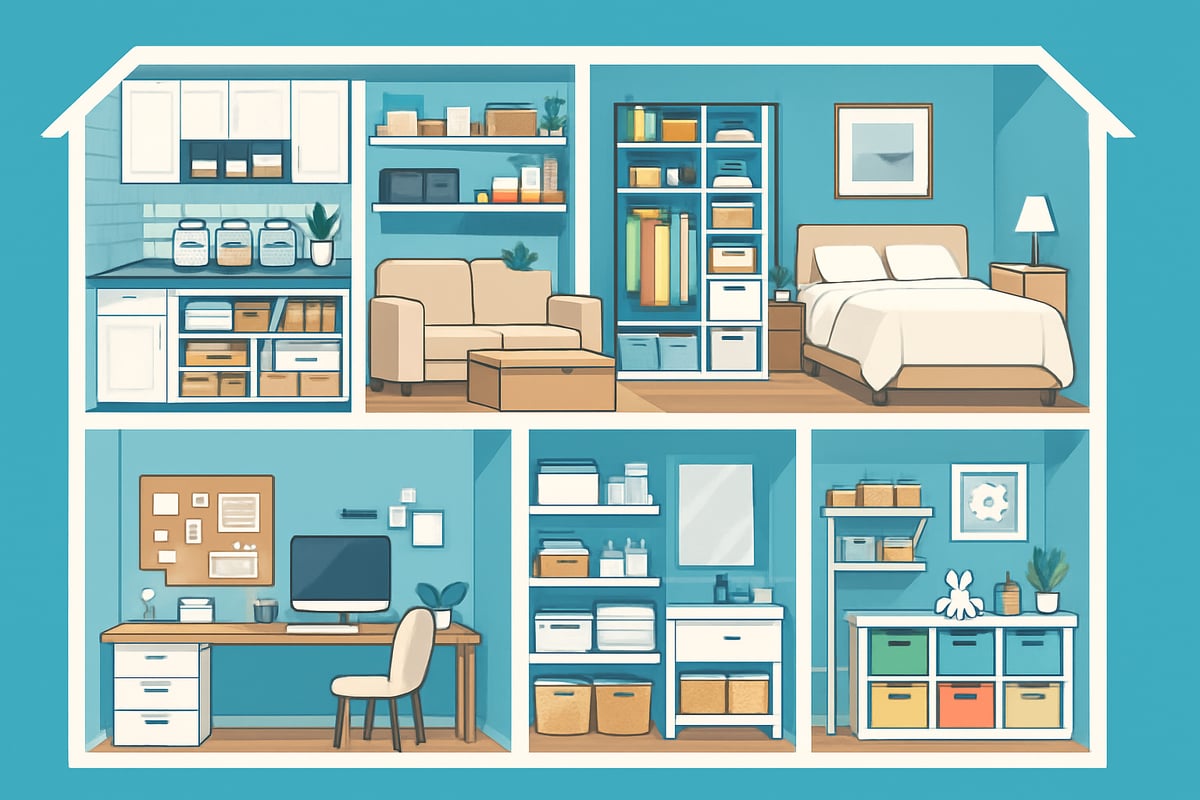
Kitchen: The Heart of the Home
The kitchen is often the command center when you organize home. Start by clearing countertops and removing anything you do not use daily. Group similar items together, like baking supplies or snacks, and use clear containers for pantry staples.
Label shelves and bins for quick access. Go through your fridge and pantry, tossing anything expired. Streamline dishware by sticking to uniform sets, which stack easily and look tidy. Drawer dividers and vertical racks make utensils and lids easy to find. Try under-sink organizers to tame cleaning supplies. Open trash cans can make cleanup faster for every family member.
A weekly reset keeps this high-traffic area functional and clutter-free. By making small changes, you set the tone to organize home with ease.
Living Room & Common Areas
Living rooms are gathering spots, so focus on keeping surfaces clear and storage accessible. Use furniture with built-in storage like ottomans for blankets or coffee tables with drawers for remotes.
Designate specific zones for activities: a reading nook, a spot for games, or a mini workspace. Entryway tables offer a landing place for keys and mail, reducing clutter before it spreads. Use attractive baskets for quick cleanup. When you organize home, these small habits prevent chaos and make every day more manageable.
Bedrooms & Closets
Bedrooms should be restful, so organizing your closet is key. Start by sorting clothes, keeping only what you love and wear. Limit shoes to a single row to avoid overflow.
Use bins and shelf dividers for accessories, and consider buying socks and underwear in just two colors to simplify laundry. Place daily essentials at eye level for easy access. Modular closet systems adapt as your needs change. When you organize home, focusing on where you begin and end your day creates a sense of calm and control.
Bathrooms & Laundry Rooms
Small spaces like bathrooms need careful planning to avoid clutter. Remove old products from countertops and medicine cabinets. Decide which items belong in closed storage and which can stay out for daily use.
Sorting hampers help organize laundry, and a simple folding system saves time. Use baskets for toiletries and cleaning supplies. Removing extra items makes even a tiny bathroom feel bigger. When you organize home, efficient bathroom routines can save you precious time every morning.
Home Office & Paperwork
A tidy home office keeps your mind clear and your paperwork under control. Start with a command center for bills, schedules, and important documents. Decide what to keep on paper and what to digitize.
Scan documents and shred what you no longer need. Use labeled folders and baskets for mail and receipts. If you want to take your office to the next level, check out these Home organization binder tips for a system that works in every room. When you organize home, a streamlined office stops paperwork from piling up.
Kids’ Rooms & Play Areas
Organizing with kids can be fun and educational. Use color-coded bins or picture labels so children can help tidy. Rotate toys to keep things fresh and reduce overwhelm.
Involve kids in daily routines by making tidying a game. Try the 12/12/12 challenge: choose 12 items to throw away, 12 to donate, and 12 to put away. When you organize home, teaching kids these habits early makes family life smoother for everyone.
Entryways, Mudrooms, and Storage Spaces
Entryways are the first line of defense against clutter. Add hooks for coats and bags, and use baskets for shoes. Only store what you use regularly in entry closets.
Switch out seasonal gear as needed to keep storage manageable. A quick daily sweep prevents piles from building up. When you organize home from the front door, the whole space feels more welcoming.
Step 3: Smart Decluttering Techniques for Lasting Results
Decluttering is the heart of any effort to organize home efficiently. In 2025, smart decluttering means more than just tossing out old items. It’s about creating lasting habits, using innovative methods, and focusing on sustainability. Let’s break down the essential techniques for a clutter-free, functional space.
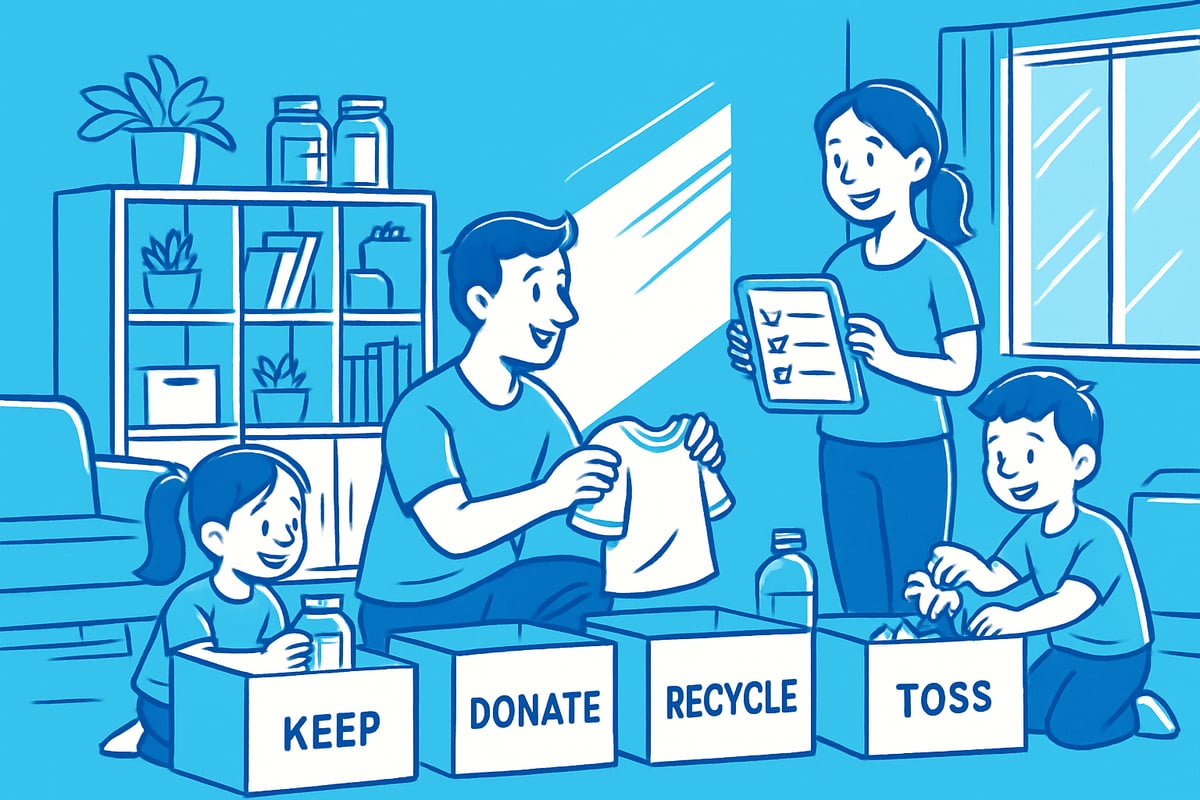
The 3 Rs: Reduce, Resourceful, Resilient
The 3 Rs form the foundation for anyone looking to organize home spaces for the long term.
- Reduce: Start by eliminating items you no longer use or need. Focus on keeping only what serves a clear purpose.
- Resourceful: Use what you already have before buying new storage solutions. Repurpose boxes, baskets, and jars.
- Resilient: Learn to adapt when something is missing. If you lose an item, try to do without it for a week before replacing it.
This mindset helps you maintain a clutter-free home and encourages smarter purchasing decisions.
Decluttering Methods and Challenges
There are many strategies to organize home environments, but the most popular include:
| Method | How it Works | Best For |
|---|---|---|
| KonMari | Keep only what sparks joy | Sentimental items |
| 20/20 Rule | Toss it if you can replace for $20/20 mins | “Just in case” clutter |
| One-Touch | Handle each item once, make a decision | Everyday items |
Dealing with sentimental items is tough. Set limits, like a single memory box per person. For even more practical tips, check out Decluttering your home with a binder for step-by-step methods using a central household tool.
Efficient Disposal and Donation
Responsibly discarding items is essential when you organize home spaces. Schedule regular donation drop-offs so items don’t pile up. Recycle electronics and textiles whenever possible—did you know 85% of textiles end up in landfills, according to the EPA?
- Donate gently used clothing and goods
- Use local recycling programs for electronics
- Arrange eco-friendly disposal for hazardous items
This approach supports sustainability and keeps your home clear.
Preventing Re-Cluttering
To organize home for the long haul, prevention is key. The “one-in, one-out” rule works wonders. Whenever you bring in something new, remove an old item. Regular mini-decluttering sessions—like monthly “edit” days for each room—also help.
- Set calendar reminders for quick decluttering
- Use checklists to track progress
- Store only what you truly use
Staying consistent will keep your home organized all year.
Motivational Tips and Accountability
Motivation is crucial when you organize home. Take before-and-after photos to see your progress. Share your goals with family or friends for extra support. Celebrate small victories, such as completing a room, with a treat or a relaxing break.
Remember, staying organized is a journey, not a one-time event. Every step you take brings you closer to a stress-free home.
Step 4: Maintenance Routines & Habits for Ongoing Efficiency
Maintaining an organized home is not a one time project but an ongoing journey. The secret is building routines and habits that fit your lifestyle and keep clutter at bay. With the right strategies, you can ensure your home stays tidy, efficient, and stress free, no matter how busy life gets.
Daily and Weekly Organizing Habits
Small, consistent actions are the backbone of a well organized home. Start with five minute tidy sessions in each room at the end of the day. Clear kitchen counters every night to set the tone for a productive morning. Once a week, do a quick reset by re homing stray items and decluttering hotspots.
Try these habits:
- Put shoes, bags, and coats away as soon as you come home
- Sort mail daily to prevent paper piles
- Sweep high traffic areas in the evening
These routines make it easier to organize home spaces and prevent messes from building up.
Family Involvement and Shared Responsibility
A truly organized home runs smoothly when everyone pitches in. Assign age appropriate tasks so each family member feels responsible for their space. Use visual chore charts or digital reminders to keep everyone on track.
For a central hub, consider creating a family command center where schedules, important papers, and to do lists are displayed. This makes it simple for everyone to stay organized home wide and reduces stress during busy weeks.
Examples of shared tasks:
- Kids can pick up toys and sort laundry
- Teens sort recycling or wipe counters
- Adults manage paperwork and bills
Seasonal and Annual Deep Cleans
Every season brings new organizing opportunities. Use the change in weather as a reminder to declutter closets, rotate wardrobes, and update storage for holidays. Spring and fall are great times for deep cleaning and reassessing what you use.
Make a checklist for:
- Swapping out seasonal gear and decor
- Donating unused clothing or toys
- Cleaning under furniture and behind appliances
These annual routines help you organize home storage and keep your systems fresh.
Adapting Systems as Needs Change
Life is always evolving, and so should your organizing systems. Whether you welcome a new baby, start working from home, or downsize, take time to reassess your routines. Flexible storage options, like modular shelves or multipurpose furniture, make it easy to adjust.
When you regularly review and tweak your approach, you ensure your organize home strategies stay effective and meet your family's needs.
Troubleshooting Common Pitfalls
Even with great habits, clutter can sneak back in. Identify your home's "clutter magnets" such as entry tables or kitchen counters. Set a reminder for quick resets and ask a friend or partner to help keep you accountable.
If you notice the same messes reappearing, revisit your routines and storage solutions. Sometimes, a small tweak or a new family system is all it takes to maintain an organized home.
Essential Tools & Resources for Modern Home Organization
Ready to organize home in a way that feels both modern and manageable? The right tools can make the process seamless, whether you are tackling one room or the whole house. In 2025, organization is all about combining smart products, digital solutions, and time-saving resources for lasting results.
Must-Have Organizing Products for 2025
When you organize home, modular shelving and stackable bins are the stars of the show. These versatile solutions adapt to any space, making them ideal for busy families and small apartments alike. Clear containers help you see what you have at a glance, while smart labels and inventory tracking devices keep everything accounted for.
Eco-conscious choices, like glass jars for pantry staples, bring both style and sustainability into your daily routine. For the latest on modular furniture and AI-powered tools, check out 2025 Home Organization Trends You Need to Know.
Digital Tools and Apps
Digital tools are game-changers when you organize home. Home inventory apps let you catalog your belongings, while shared family calendars ensure everyone is on the same page. Task managers and reminder apps streamline routines, and voice assistants help with quick lists or schedule updates.
Integrating technology into your system allows for real-time updates and easy access, making it simple to stay organized even with a busy lifestyle.
Printable Planners and Checklists
Sometimes, the simplest tools are the most effective. Printable planners and room-by-room checklists guide you through each step as you organize home, breaking big tasks into manageable pieces. Maintenance schedules and decluttering guides help keep your system on track.
Having these resources on hand makes it easy to delegate tasks and celebrate progress, especially during seasonal resets or deep cleans.
Professional Help and Community Resources
If you organize home and feel stuck, professional organizers offer expert support and tailored solutions. Many families also benefit from tapping into community resources, like local donation centers and recycling programs.
These services help you responsibly dispose of unwanted items, making the process of decluttering more rewarding and eco-friendly. Sometimes, a fresh perspective is all you need to overcome organizing roadblocks.
The Family Binder: The Ultimate Family Organization System
The Family Binder is a comprehensive, printable, and editable PDF planner designed to centralize all your family’s vital information—financial, insurance, home, kids, pets, and estate plans—in one secure, easy-to-access document.
Ideal for families seeking to streamline their home organization and ensure important details are always accessible, especially during emergencies or transitions.
Features over 70 fillable pages covering contacts, maintenance, insurance, finances, debts, estate documents, and digital logins.
User-friendly, instantly downloadable, and customizable to fit any family’s needs—no financial expertise required.
Empowers families to proactively manage their household, reduce stress, and maintain peace of mind by keeping everything organized in one place.
Complements the room-by-room organizing methods discussed in this guide by providing a centralized “family command center” for critical information.
Especially valuable for parents, caregivers, retirees, and anyone wanting to ensure their loved ones can easily manage affairs if needed.
Learn more or download The Family Binder to take your home organization to the next level.
As you start putting these organization tips into action and rethink how your home runs in 2025, don’t forget the power of having everything truly in one place. We both know life gets busy and details slip through the cracks—so why not give yourself peace of mind by gathering all your essential family info, from finances and insurance to emergency contacts and home upkeep, in one simple spot? The Family Binder is designed to complement everything you’ve just read, acting as your family’s personalized command center. Ready to feel even more in control? Download Now
